- Offensive Techniques & Strategies
High Post Split Offense
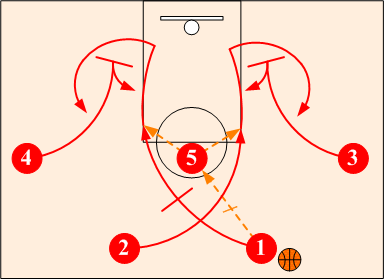
What to Discover or Recall . . .
The High Post Offense has been a staple ever since the game was invented.
It's simplicity makes it a great offense from the youth to profession level.
It is comprised of quick hitting high post splits, down screens and back cuts making it hard to guard.
In addition, the High Post Offense lends itself readily to various entries to take specific advantage of individual player skills and strengths.At first glance the High Post Split Offense may look simple, but it is its execution that has made it so devastating over the years. Because of its simplicity, it affords the offensive players the luxury of concentrating entirely on its execution. With its 2-3 high player alignment, it frees up the baseline providing for quick basket cuts and back cuts against any defensive overplay.
Since the High Post Offense affords scoring opportunities for all five players on the court, it prevents the defense from concentrating on stopping one or two offensive players. With this constant threat of all of the players without the ball, it also eliminates any weakside defensive help. In addition, the High Post Offense provides for extremely, strong offensive rebounding and second efforts. As a result, the High Post Offense is an offense that players love to play and coaches love to coach.
| Post Split | Down Screens | HP Isolation | Post Ups | Variations | Rebounding | Installing | Case for Defense |
Schematic Sequence

Offensive Fundamentals Required
 Creating Leads - Proven Techniques to Get Open
Creating Leads - Proven Techniques to Get Open

Phase 1: High Post Split
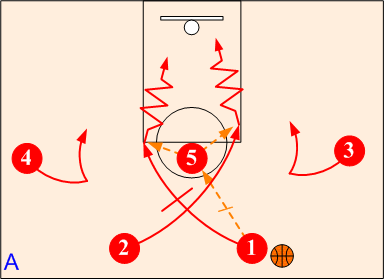
| Split | Fake Split | Back Cut | Two Same Side |
The basic option is for one of the guards to hit the high post and split the post. The guard making the pass to the high post cutting first, the other guard cuts tight off the first guard's moving screen. The high post has the option of feeding either guard. Wings O3 and O4 set up for down screens.
Split Reads & Counters
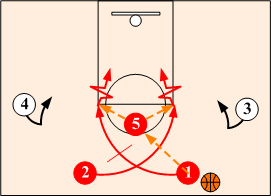
Read: Defenders play tight and do not switch.
Counter: Handoff on Split
Basic option is for the high post to feed either guard cutting to the basket.
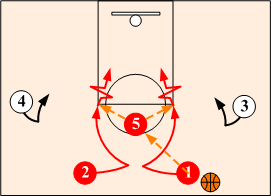
Read: Defenders drop off anticipating split and switch.
Counter: Fake Split
Guards have option of faking the high post split and cutting same side to the basket.

Read: Defenders anticipate the split and sag off on post or watch the ball.
Counter: Direct Basket Cut
Any time the defenders anticipate the post split and collapse on the post, the guards have the "Green Light" to back cut directly to the basket for shot.
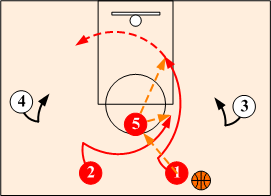
Read: Defenders anticipate and automatically switch.
Counter: Two Same Side
When the defenders drop off and automatically switch, both cutters can go same side creating a two-on-one situation on X1.

Phase 2: Down Screens
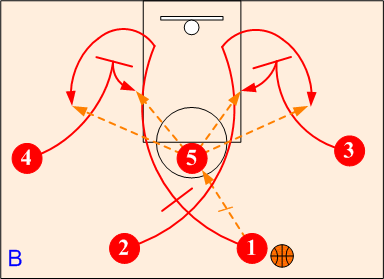
When the high post does not feed either splitting guards, wings O3 and O4 set down screens for guards O1 and O2. Post O5 looks to pass to O1 or O2 coming off the down screens or to feed screener O3 or O4 rolling to the basket off their down screens, if the defense switches. Post O5, isolated, also has the option on shooting or driving to the basket one-on-one.
Available Down Screen Options
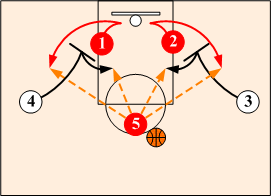
Read: Defenders defend high post split.
Counter: Down Screen
When a shot is not available off the high post split, the wings O3 and O4 set down screens for the guards. If the defenders switch on the down screens, post O5 looks to feed the screeners rolling to the basket on mismatches.
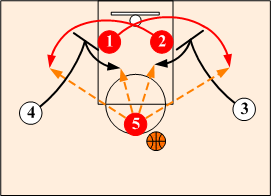
Read: Defenders anticipate the down screens.
Counter: Double Split
Guards cross under the basket (touching right hands) and pop out opposite off the down screens.
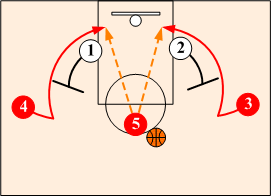
Read: Defenders anticipate the down screens.
Counter: Back Screen
After the guards split the post, they have the option of stepping out and setting back screens for the wings. Post O5 looks to feed wings on back cuts or if the defense switches, posting up against smaller defenders.
Successfully Executing Down Screens
Although during a game, a team will only deploy one or two methods of defending down screens, players need to possess a working knowledge of all the defensive various reads and counters. However, coaches must stay active and alert to any defensive changes that the opponent may make during a game.
Basic Reads and Counters. What if the defender . . . .
Click on desired read below to view illustrated counter option.
-
What if the defender CHASES & TRAILS the receiver? Curl
-
What if the defender CHASES OUT LATE & TRAILS the receiver? Basket Curl
-
What if the defender goes CHEATS OVER the screen? Fade
-
What if the defender goes CHEATS OVER the screen EARLY? Back Cut
-
What if the defenders SWITCH against the screen? Screen & Roll
Smaller defender is MISMATCHED INSIDE against post.
Bigger defender MISMATCHED OUTSIDE against quicker ball handler.
-
What if the defenders SHOW & RECOVER on screen? Slip the Screen
Read: Defender CHASES OUT and trails the receiver.
Counter: Curl
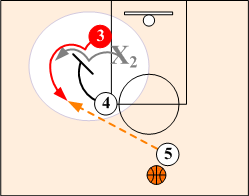
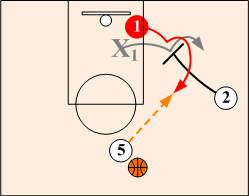
When the defender CHASES OUT, the shooter curls off the screen for a quick open jump shot.
Read: Defender CHASES OUT LATE and trails the receiver.
Counter: Basket Curl
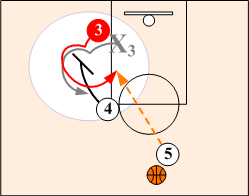

Note: When the defender CHASES OUT late, the shooter can curl all the way to the basket.
Read: Defender CHEATS OVER the screen.
Counter: Fade
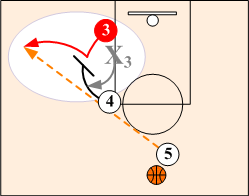
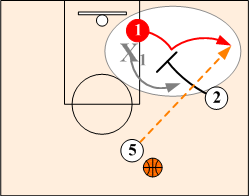
When the defender goes OVER the screen, the shooter should fade to baseline for open jumper.
Read: Defender CHEATS OVER the screen EARLY.
Counter: Back Cut
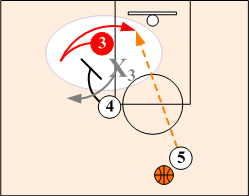

When the defender anticipates and CHEATS OVER the screen early, the shooter can change direction and back cut to the basket for shot.
Read: Defenders SWITCH on the Down-Screen.
Counter: Screen and Roll
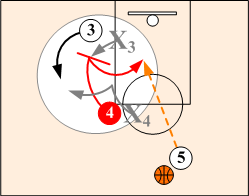
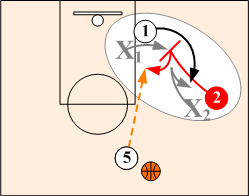
When the defenders SWITCH on the down screen, the receivers pops out to the wing, and the screener "Seals Off" the defender and rolls to the basket for shot.

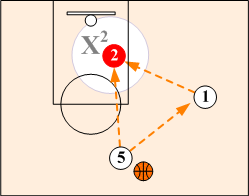
Post Isolation
When defenders Switch, the receiver pops out directly out to the wing allowing post to exploit smaller defender. The high post can either feed post directly or pass to any of the peripheral players for the post feed.
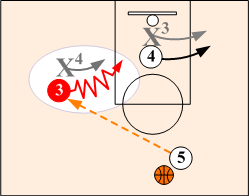
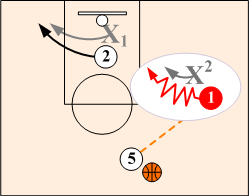
Wing Isolation
When the defensive players switch, the screener can clear out to weakside isolating the shooter one-on-one on the wing against bigger defender X4. If the wing's shot is not available, the post can then dive to the basket to exploit smaller defender X2.
Read: Defenders SHOW & RECOVER against the down screen.
Counter: Slip the Screen

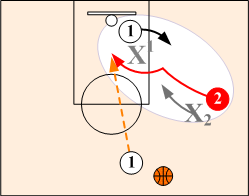
When the screener's defender SHOWS to help out on the down-screen, the screener immediately breaks off the screen and cuts away to the basket for shot.

Phase 3: High Post Isolation
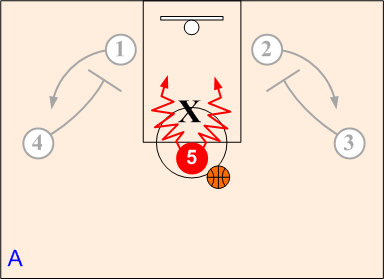
Once the guards split the post, the high post makes a strong pivot and faces the basket assuming a triple threat position. From the triple threat position, they can drive, shoot or pass. Since the ball is located in the middle of the court ("Red Zone") the high post's defender X5 has no defensive help, isolating the high post one-on-one.
Note: High post has "Green" light to shoot or drive any time they have an advantage.
Automatic Post Lob vs Post Overplay
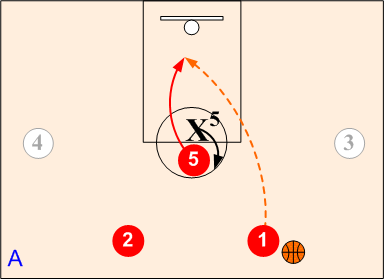
When the pass to the high post is overplayed, post O5 releases to the basket for an "over the Top" lob pass. Other counters against the high post overplay:

Wing Feeds
If the ballhandling guard cannot feed the post direct, they can pass to either wing, who in turn, can feed the high post rolling to the basket.
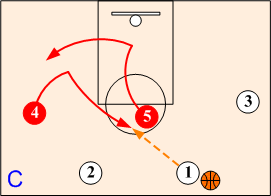
Post Exchange
If the high post releases to the basket, they can empty out to the weakside wing. The weakside wing then breaks into the high post position.
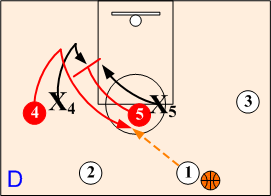
Screen Exchange
An high post exchange can also be initiated by the high post setting a diagonal down screen for the weakside wing.
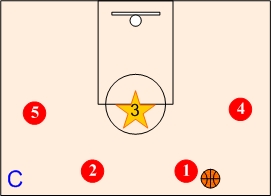
Player Interchange
The high post position is not limited to just the post player. It should be occupied by the best triple threat player.

Phase 4 Strong Post Ups
When the defense focus on stopping the shooters, the ball handler O1 looks inside to feed O4 or O5 posting up strong against smaller defenders. All players should be proficient in posting up strong and executing basic post moves.

Entry Variations

Many teams have adapted the 2 -3 high post player alignment to take advantage of their specific player personnel. Some of the more frequently used variations include "Flop" or Back Cut Entry, Wing Pass Entry, Wing Double Away Entry and Post Single/Double action. Click below to view their illustrated details:
Click on desired proven variation below to view illustrated details.
| Flop Entry | Wing Pass Entry | Wing Double Away Entry | Post Single/Double |
Wing Flop (Back Cut) Entry
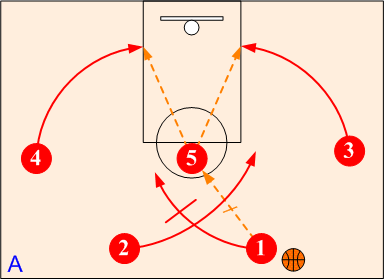
When the wings get over played by defense they have the option of back cutting to the basket. The guards split the post and down screen for the wings. The high post has the option of feeding either wing on the back cuts.
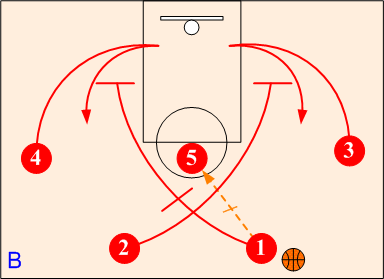
When the high post does not feed either wing on back cut, guards O1 and O2 set down screens for wings O3 and O4. Post O5 looks to pass to O3 or O4 coming off the down screens or to feed screener O1 or O2 rolling to the basket or popping out off their down screens, if the defense switches. Isolated post O5 also has the option on shooting or driving to the basket one-on-one.
Note: When the high post does shoot the ball, the offense has a definite inside rebounding advantage.
Back Cut Option
Read: Defenders overplay wings.

Basic option is for the high post to feed either guard cutting to the basket.
Down Screen Option
Read: Defenders defend back cuts.
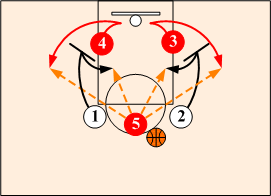
When a shot is not available off the back cuts, the splitting guards set down screens for the wings. If the defenders switch on the down screens, post O5 looks to feed the screeners rolling to the basket.
Base Cross Option
Read: Defenders trail on the down screens.
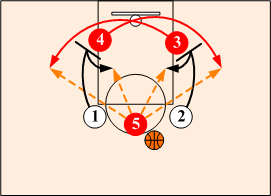
Wings cross under the basket (touching right hands) and pop out opposite off the down screens.
Pop Option
Read: Defenders drop off to defend back cuts.
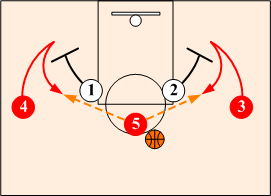
When the defenders sag off to protect against the back cuts, the wings fake the back cuts and pop out early over the splitting guards down screens for shot.
Wing Pass Entry
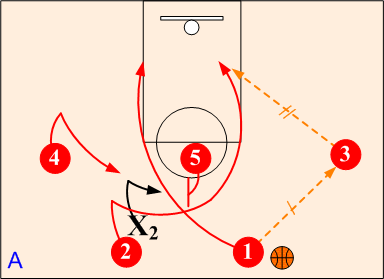
Ballhandler O1 makes an entry pass to wing and then splits the post with O2. Wing O3 looks to feed O2. All reads and counter options are available to O1 and O2 on high post split.
Ball Reversal
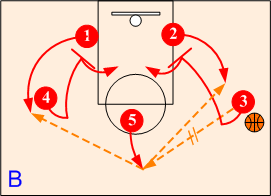
If a good shot is not available off high post split, O3 makes a reversal pass out to O5. O3 and O4 down screen for O1 and O2. If the defense switches O5 looks to feed O3 or O4 rolling to the basket or posting up strong against the smaller defender.
Motion Continuity
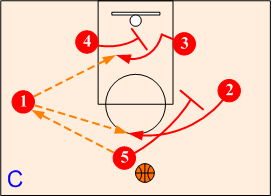
When O5 passes to a wing, it initiates the motion continuity with O4 and O5 screening across for O3 and O2. Anytime the ball is passed out to the point, down screens are initiated.
Wing Pass - Double Away

Ballhandling guard O1 passes to wing O3 and executes a high post split with O2. Wing O3 looks to feed O2 cutting to the basket or posting up strong. Guard O1 and post O5 set a weakside double screen for wing O4.
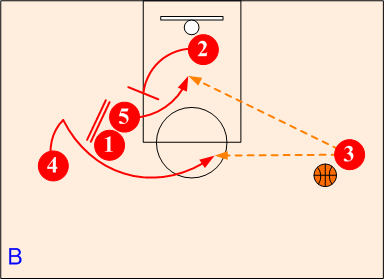
If O2 is not open off the high post split, wing O3 looks to pass to O4 coming off O1's and O5's double screen or to feed O5 rolling to the basket off O2's baseline back screen.
Post Single/Double Screen
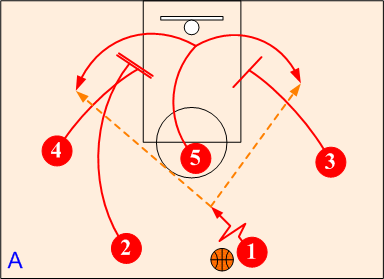
When the high post releases to the basket the Single/Double Screen continuity becomes an option. This puts additional pressure on the high post's defender.
Double Screen Option
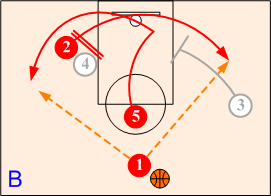
When the high post goes off the double screen, O2 releases and goes opposite off the single screen.
Single Screen Option
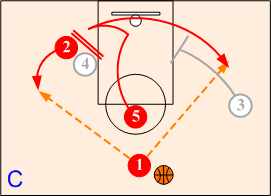
If the high post goes off the single screen, O2 pops out same side off of screener O4.

Offensive Rebounding

The importance of offensive rebounding to the outcome of the game cannot be over emphasized. Simply stated, even if you shoot well, it is going to be very difficult to win if you get only one shot. Rather than size and strength that is required for defensive rebounding, offensive rebounding requires anticipation, determination, and hustle. Players must develop an attitude as well as an instinct for the ball. They must be aggressive and determined. Second, Third and Fourth efforts should be common place to offensive rebounding.

Anytime the high post shoots the ball, the offense has a definite inside rebounding advantage. However, to capitalize on this advantage, players must assume that all shots will be missed and "Box Out" their defenders.
 Offensive Rebounding Techniques
Offensive Rebounding Techniques

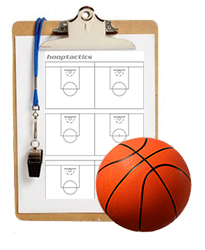
Teaching & Implementing the High Post Split Offense

The key to the success of the High Post Split Offense is in its spacing, execution and coordination. Players need to be well prepared to execute high post splits and down screens along with strong post ups. The ballhandler, screener and receiver must think and function as one unit. This requires non-verbal communication, timing, and, most of all, defensive recognition.
Caution: Before undertaking any offense, players must have a solid, working knowledge of all of its components.
Breakdown Drills:
 2-on-2 Combination Down Screen, Post Ups and Side Screen
2-on-2 Combination Down Screen, Post Ups and Side ScreenThe Game Within a Game
Individual offensive skill development and improvement should be an integral part of every practice. In addition to early time (before practice) work, each player should, personally, have one or two individual fundamental techniques to work on during the course of a practice. The specific skill or skills will vary from player to player and can be assigned by the coaching staff or determined by the players themselves. As a reminder, it is wise to write the skill(s) down on a 3 X 5 card and give it to each player prior to practice.

The Case for the Defense
Even if you do not plan to use the High Post Offense, you better know how to defend against it.
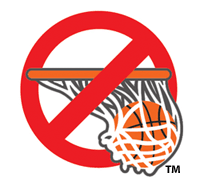
Continue and learn how to defend the high post split offense.
Return to Set Offenses - Click Here
Return to Offensive Strategies - Click Here
Return to HoopTactics - Click Here
© 2026 HoopTactics All Rights Reserved.
